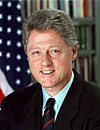 | |
| Long title | An Act To amend title III of the Immigration and Nationality Act to make changes in the laws relating to nationality and naturalization. |
|---|---|
| Acronyms (colloquial) | INTCA [1] |
| Enacted by | the 103rd United States Congress |
| Effective | October 25, 1994 |
| Citations | |
| Public law | Pub. L. 103–416 |
| Statutes at Large | 108 Stat. 4305 |
| Codification | |
| Acts amended |
Immigration and Nationality Act of 1952 Immigration Act of 1990 |
| Legislative history | |
| |
The Immigration and Nationality Technical Corrections Act of 1994 (INTCA or H.R. 783), Pub. L. 103–416, 108 Stat. 4305, enacted October 25, 1994, was an act by the United States Congress "to amend title III of the Immigration and Nationality Act to make changes in the laws relating to nationality and naturalization." [3] Introduced by Romano Mazzoli, the act amended the Immigration and Nationality Act by allowing the acquisition of United States citizenship from either parent for persons born abroad to parents, only one of whom is a United States citizen. [4]
The INTCA also prospectively expanded the definition of " aggravated felony", under which non-citizens were subject to deportation, [5] by adding more criminal convictions. [6] Some of these new additions related to crime of violence, theft, ransom, child pornography, racketeering, prostitution, tax evasion, fraud and alien smuggling. [7] [8]
The act was signed into law by President Bill Clinton, who said in his signing statement that act would correct the injustice towards persons born outside of the United States, and only one of whose parents was a United States citizen. Prior to the act, such persons could only acquire citizenship if that parent was the father. [9] The act amended this condition to allow acquisition of US citizenship when either of the parents was a US citizen. [4]
See also
- Anti-Drug Abuse Act of 1988
- Immigration Act of 1990
- Antiterrorism and Effective Death Penalty Act of 1996 (AEDPA)
- Illegal Immigration Reform and Immigrant Responsibility Act of 1996 (IIRIRA)
Notes and references
- ^ "Campos v. INS, 62 F.3d 311". U.S. Court of Appeals for the Ninth Circuit. Harvard Law School. August 4, 1995. p. 314.
- ^ "Representative Romano L. Mazzoli". U.S. Congress. Retrieved 2021-12-06.
- ^ "Pub. L. 103-416 Immigration and Nationality Technical Corrections Act of 1994". United States Citizenship and Immigration. Retrieved 18 March 2012.
- ^ a b "Immigration and Naturalization Service" (PDF). Department of Justice. Retrieved 18 March 2012.
- ^ "III. Deportation Law Based on Criminal Convictions Before 1996". Forced Apart. Human Rights Watch. Retrieved 18 March 2012.
-
^
"Matter of B, 21 I&N Dec. 287" (PDF). Board of Immigration Appeals. U.S. Dept. of Justice. March 28, 1996. p. 288 n.1.
Congress expanded the definition of the term 'aggravated felony' in the Immigration and Nationality Technical Corrections Act of 1994.... However, the 1994 Act specifies that its amendments to section 101(a)(43) of the Act shall apply only to convictions entered on or after October 25, 1994.
(emphases added) - ^ "Title II—Technical Corrections of Immigration Laws: Sec. 222. Expansion of Definition of Aggravated Felony" (PDF). U.S. Congress. U.S. Government Publishing Office. pp. 16–18.
- ^ "III. Deportation Law Based on Criminal Convictions Before 1996". Forced Apart. Human Rights Watch. Retrieved 18 March 2012.
- ^ "Statement on Signing the Immigration and Nationality Technical Corrections Act of 1994". The American Presidency Project. University of California, Santa Barbara. Retrieved 18 March 2012.
External links
- "Matter of Saint John, 21 I&N Dec. 593" (PDF). Board of Immigration Appeals. U.S. Dept. of Justice. September 23, 1996. p. 595.

